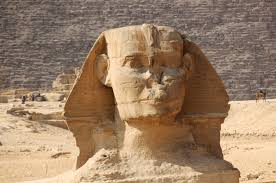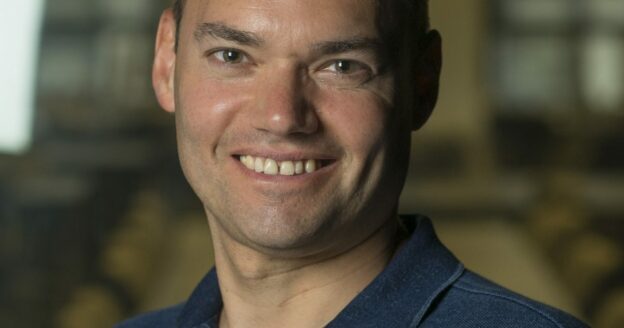And an essay I wrote about the joys of large families was published by Religion News Service last week. It’s here.


And an essay I wrote about the joys of large families was published by Religion News Service last week. It’s here.

Two indistinguishable goats were brought on Yom Kippur before the Kohein Gadol, who placed a randomly-pulled lot on the head of each animal. One lot read “to Hashem” and the other “to Azazel” – the name of a steep cliff in a barren desert.
The first was sacrificed as a holy korban; the second, taken to the cliff and thrown off, dying unceremoniously before even reaching the bottom.
There are two ways to view human life, either as the result of intent or the product of accident. And a corollary follows: Either our lives are meaningful, or they are not.
If the roots of our existence ultimately lie in randomness, there can be no more meaning to good and bad actions than to good or bad plays; no more import to right and wrong than to right and left. Societal norms can be promoted, but a social contract is a practical tool, not a moral imperative. Only if there is a Creator in the larger picture can there be ultimate import to human life, placing it on a plane meaningfully above that of mosquitoes.
The Torah’s most basic message is the meaningfulness of human life.
Might the goat brought as a korban symbolize recognition of the idea that humans are beholden to something greater? And the counter-goat, fate to a desolate, unholy place, allude to the perspective of life as pointless, lacking higher purpose?
Strangely, the Azazel-goat is described by the Torah as carrying away the people’s sins.
Might that mean that sin stems from not realizing how meaningful our lives are? And might a reminder about that idea on the holiest day of the Jewish year spur thoughts of repentance, of re-embracing the grand meaningfulness that is a human life?
© 2024 Rabbi Avi Shafran

Ours are times when it isn’t hard to imagine oneself as a Jew in Mitzrayim – at least according to the way two commentaries understand a word in Devarim.
The word is in one of the pesukim comprising the declaration to be made by those bringing bikurim, the firstfruits of the season, to the Beis Hamikdash. It is, famously, a declaration that the Haggadah expands upon. The word is vayarei’u, often translated as “they [the Mitzri’yim] treated us in an evil way” (26:6).
Abarbanel and the Netziv, however, see the syntax of the word as implying something subtly but decidedly different. They read it as meaning “they ‘eviled’ us” – in other words, they portrayed the descendants of Yaakov as evil. As we would say in English, they vilified us.
Could there be a better way to describe so much of the world’s attitude toward Jews today? To be sure, there are always haters who, as is their wont, hate, for any of an assortment of “reasons” or with no attempt at “justification” at all; that’s nothing new.
But, as a result of civilian casualties in Gaza – unavoidable deaths and injuries like those that have been part of every war in history – Israel has been vilified to an unprecedented extent, not only by the usual suspects but in broad international circles and media. And, tellingly, all Jews – as Jews, simply for being Jews, our opinions unknown and of no concern to the venomous vilifiers – are targeted as well.
Attacks on Jews, physical and verbal, abound across the globe. The despicable chants of “Burn the Jews!” and displays of Nazi symbols at “pro-Palestinian” rallies – a British bobby was recently recorded dismissing a distraught Jewish woman’s complaint about swastika flags at a demonstration by saying they needed to be “taken into context” – is evidence enough of how easily empty-headed people can, under the self-righteous guise of what they proffer as principled political positions slide into… vilification of Jews.
And so it’s no great challenge this year to put ourselves in the places of our vilified ancestors in Mitzrayim. The Haggadah’s mandate that we endeavor to see ourselves as if we, too, were redeemed from Mitzrayim logically includes imagining ourselves in the state that our forebears endured before they went free. After all, an appreciation of redemption must include what it has freed one from.
Although we refer to the splitting of the Red Sea as kri’as Yam Suf, a “tearing” of the waters, that word is not used by the Torah. The Torah’s word for the parting of the waters is vayibak’u – “splitting” or “chopping.”
Noting the use of the same verb to describe Avraham Avinu’s splitting of wood for use in the offering of Yitzchak as an olah to Hashem, Chazal tell us that it was in the merit of that action of Avrohom’s that the sea was able to split.
What was the essence of that merit? It’s more than plausible that it was the perseverance in the face of hopelessness, the selfless determination with which Avraham undertook to follow Hashem’s unfathomable command. Our forefather’s deepest desire lay in a world-changing future for Yitzchak and his eventual descendants. But, it seemed, in light of the command, that there was no hope left to be hoped.
Similarly, when Klal Yisrael found itself faced with a sea before them and an approaching army closing in from behind, hopelessness would understandably have seized them.
And yet, just as the despair Avraham had reason to feel as he split wood for the akeida was later dissipated in a crucial instant, so did the anguish our ancestors experienced at the sea suddenly evaporate, as they watched the waters before them part.
It’s a thought worth pondering these days. Even surrounded by darkening clouds of seemingly mindless, relentless hatred, we do well to remember how hopelessness needn’t be final.
The Egyptian pyramids and the Sphinx, intended to herald the permanence of the power of an ancient dynasty, are today nothing more than tourist attractions, and crumbling ones at that. Our people persists, vibrant and hopeful, looking toward the ge’ulah sheleimah.
© 2024 Ami Magazine

We instinctively think of nega’im as born of lashon hora, “evil speech,” and we’re not wrong. But there is another birther of the condition, one that is evident in the very word metzora: tzarus ayin, “miserly eye” – selfish narrowmindedness, begrudging others one’s possessions.
That is particularly evident in the fact that, in the case of nig’ei batim, the tzara’as that afflicts walls of a house, the owner, before the house is declared tamei by a kohein, is told to take the home’s vulnerable vessels outside, exposing them to public view. What’s more, the Torah’s concern for the owner’s possessions stands as a lesson to him about caring for others’ needs.
Jews, as a people, are famously generous. We may be frugal, but that bespeaks something positive, our recognition of the worth of even small things. When it comes to charity, though, U.S. Jews per capita are more philanthropic than any other ethnic or religious community.
But tzarus ayin can manifest itself in a realm apart from charity. The Kli Yakar sees in the phrase “asher lo habayis” – “that is to him the house” (Vayikra 14:35) – an indication of a miser’s mindset: he thinks the house is truly his, when, in reality, it, like all we may think we “own,” is only temporarily in his control, on loan, so to speak, from Hashem.
Chazal created an entire class of imperatives based on that reality: birchos hanehenin, “blessings to be made before indulging.” When we recite a brachah before enjoying food or even fragrance, we are acknowledging that what is about to benefit us is from Hashem.
It’s ironic that a society like ours today, so blessed with such plenty, is not more careful when it comes to acknowledging our blessings. “Bruchanoi” may be somewhat reminiscent of the first three words of a brachah, but only somewhat. And quickly mumbling a brachah as some sort of irksome incantation without thinking about what its words mean is no replacement for summoning the gratitude the brachah is meant to express.
Even generous eyes can be miserly. Ours shouldn’t be.
© 2024 Rabbi Avi Shafran

An “aptronym” is a person’s name that is amusingly appropriate — like that of the lawyer named Sue Yoo, or of BBC meteorologist Sara Blizzard.
I’ve got another one, at least for Hebrew speakers. To read what it is, click here.

I wonder if Peter Beinart would regard a white robe and tall pointed hood as a mere fashion statement.
To read why I ponder that, click here.

Tum’ah, or “ritual defilement,” is invisible but consequential in many contexts, especially, though not exclusively, with regard to kodoshim, material holding holy status.
And, in most cases of tum’ah impartation, the defilement happens as a matter of course, through contact of one sort or another with a source of tum’ah.
Tzara’as, the skin condition that occupies the bulk of parshas Tazria, is different. It is wholly dependent on the judgment, based on the detailed laws in the parsha, of a kohein.
And not just his judgment but his pronouncement of “tamei.”
Hence, we have the law that a groom with a sign of tzara’as is to be given seven days of wedding celebration before presenting his condition to a kohein; and anyone with such a sign does not bring it to a kohein during a holiday (Rashi Vayikra 13:14, based on Moed Katan 7b). No pronouncement of tum’ah, no tum’ah.
At least in the case of skin tzara’as, which, it is taught, results from lashon hara, speaking ill of others, the oddity of the tuma’ah being dependent on a pronouncement might telegraph a subtle message to the afflicted person: Speech is powerful. It can be destructive, as in lashon hara, the source of tzara’as. And withholding it can be consequential in a positive way, preventing tum’ah from manifesting. It is what sets humanity apart from the animal world.
It’s fitting, in other words, that the status of a condition brought about by speech is dependent on speech.
© 2024 Rabbi Avi Shafran

Anyone interested in a 54-page compendium of Pesach-themed articles I have written over the years is invited to request one (no charge) at rabbiavishafran42@gmail.com .

The New York Times has made some progress when it comes to accurately describing what Judaism considers the holiest spot on earth. To read what I mean, click here.

When describing the camel and pig, animals that lack either of the two signs required for their species to be considered consumable by Jews, the Torah’s wording is odd.
Kosher species require cud-chewing and split hooves, yet the camel, the text states, is forbidden “because it chews its cud, but does not have a [completely] split hoof”; and the pig, “because it has a cloven hoof that is completely split, but will not regurgitate its cud.” The “becauses” are seemingly misplaced, since the reason for the species’ forbiddance is for the lack of one kosher sign, not the presence of one.
Similar wording is used regarding the two other “one sign only” species mentioned, the hyrax and the hare.
The Kli Yakar perceives something poignant in the placement of the kosher signs after the “becauses.” He writes that “their pure sign adds extra impurity to their impurity, as we find that Chazal compared Esov to a pig that sticks out its hoofs when it lies down to make it appear as if it is kosher, but its inside is full of deceit. This represents anyone whose inside is not like his outside, in the manner of the hypocrites … Therefore, the pig’s split hoof is a sign of impurity because the split hoof can deceive people and make it appear as if it is kosher.”
The Chashmonai king Yannai, before he died, told his wife “Don’t be afraid of the Perushim [Torah-faithful Jews] or of those who are not Perushim, only of the hypocrites who present themselves as Perushim, for their actions are those of Zimri while they ask for reward like Pinchas received” (Sotah 22b).
Presenting oneself as a better version than that of one’s reality, Rav Yaakov Weinberg, zt”l, once told me, isn’t wrong – if one aspires to that better version. As the Chinuch put it, “what is on the outside can awaken the inside.”
But pretension for the sake of pretension is being, well, piggish.
© 2024 Rabbi Avi Shafran